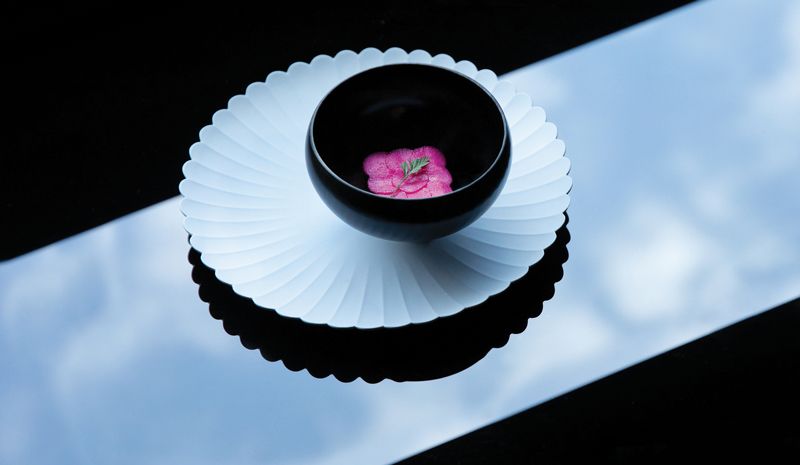“If you’re a well-trained chef, you can taste something and know instinctively how to make it shine.”
—Niki Nakayama
At the two-Michelin-star n/naka restaurant in Los Angeles, chef Niki Nakayama creates an exquisite dining experience rooted in the traditional Japanese art of kaiseki. Her plating has the flair of a genuine artist—visually stunning with a sincere appreciation for seasonal ingredients. Her goal with every dish is to engage the five senses and to create a moment of undistracted connection with the food.
The old ways of kaiseki come from Japan’s ancient monasteries, which brought a layer of divine significance to the arts of cooking and eating, elevating them to something transcendent.
Nakayama builds on these traditions with her creations at n/naka. She also teaches people how to elevate their home-cooked experiences with an online masterclass in traditional Japanese cuisine.

Tell us a bit about the tradition of kaiseki and the experience you aim to create through cooking.
The philosophy of kaiseki is deeply rooted in Zen Buddhism. What resonates with me is the appreciation of the moment—this very particular moment, the moment of now.
I think there’s something very meaningful about experiencing something when you’re not distracted by things that are not of this moment. So much of our lives are focused on either the past or the future. We’re constantly busy, but once in a while we’re able to be steeped in one particular moment. The pleasure of kaiseki comes from forgetting everything else and getting lost in that experience.
How does your approach differ from traditional kaiseki?
Traditionally, kaiseki is a multi-course dinner that was originally very simple. The newer version is more elaborate. We call ours the modern kaiseki, and it’s less limiting in terms of seasonings and ingredients.
Traditionally the flavours, style, and ingredients had to be purely Japanese. We’re more flexible. We use a lot of local Californian ingredients that represent this area, and we follow the cooking methods that best showcase these ingredients. We take the philosophy of kaiseki and apply it within our environment here.
We like to introduce different flavour profiles that aren’t necessarily traditional, so people can experience the juxtaposition of something traditional with something non-traditional. A lot of kaiseki restaurants tend to be very quiet and very temple-like, but ours isn’t like that. We want people to have a good time and enjoy the whole experience without feeling like they have to be very proper.
Tell us more about the importance of honouring the ingredients.
I always equate cooking and specific ingredients with words. The power of language comes from understanding how to use words properly, and this also applies to ingredients. In order to enjoy what a particular ingredient has to say, you have to understand its nuances.
If you can’t taste or distinguish any of the ingredients within a dish, they lose their identity. If you wanted to highlight a carrot, for example, and you’re hiding this carrot with other flavours, the carrot never comes through and you’ve lost its meaning. The biggest aspect of Japanese cooking is honouring the ingredient.
We laugh about it, but we’re always saying things like, “Listen to the ingredient. It tells you what it wants to be.” If you’re a well-trained chef, you can taste something and know instinctively how to make it shine.
Maybe this wonderful carrot just needs some salt. Or maybe you taste it and think, “No, I think it’ll really be enhanced if I do a tempura fry. Or I could blend it with something else so that the bitterness dissipates and the sweetness comes out.” It’s an understanding of how to coax out its wonderful parts. That’s what we mean by listening to the ingredient.

How do you communicate your philosophy and the principles of kaiseki through your work?
Our goal is to help people achieve an experience of “now-ness,” of appreciating the moment. We always say that from the time the guests make the reservation to the moment they walk out, it’s a wholeness. My goal is for them to forget, on some level, that they’re in the middle of L.A. where they are bombarded with all kinds of stimuli. When they come in, our job is to transport them to just this moment and to forget about everything else in the world.
When we were preparing our newest menu for autumn, we asked, “How shall we express on the plate what’s happening in nature?” We want to create dishes that remind people of certain feelings they may have during the season. This is a conscious effort to lead them into this particular moment.
I love all the colours during the autumn season, and the change from the happiness of summer to the cooler weather. All those little things make up how we experience our lives, and if we’re evoking a few of those feelings throughout, then we’re helping build associations. I think that’s where we want to guide the diners at our restaurant.
How can people take this idea of being immersed in a moment and apply it to other aspects of their lives?
We don’t want people to feel overwhelmed by these ideas. It’s just something that we put out there, hoping that they can remember a little bit of it and connect. I think the idea of kaiseki and cooking is something that people can genuinely practice anywhere.
Kaiseki is a very particular cuisine, but the whole concept of immersing yourself in a moment and really appreciating it can be applied to Japanese cuisine more broadly, as well as to other types of cuisine and areas of life.
That’s what the kaiseki philosophy is about—the understanding that life is ever-fleeting. It’s worth thinking about and taking time to value small and meaningful moments. At n/naka, we’re interested in a crafted experience that allows people to escape their normal reality and to experience special moments through their senses.